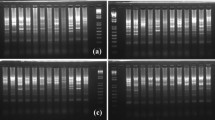Abstract
Crop germplasm collections contain a considerable percentage of misclassified accessions which may affect the use of germplasm for agricultural crop improvement. The objective of this study was to determine if random amplified polymorphic DNA (RAPD) analysis could be used to reclassify misclassified Triticum accessions. Twelve accessions suspected to be misclassified, based on morphological characters, as either macha or vavilovii wheat were studied using RAPD and cytological analyses. In the RAPD analysis, a dendrogram, based on Jaccard genetic similarity coefficients, grouped 5 dicoccum-like, 1 timopheevii-like, and 6 monococcum-like accessions with Triticum dicoccum, T. timopheevii, and T. monococcum accessions, respectively. These results were confirmed by the cytological analysis. A RAPD marker specific to the D genome was also detected. This study suggests that RAPD analysis can be used to classify germplasm and to distinguish some species in Triticum.
Similar content being viewed by others
Author information
Authors and Affiliations
Additional information
Received: 12 June 1998 / Accepted: 18 August 1998
Rights and permissions
About this article
Cite this article
Cao, W., Scoles, G., Hucl, P. et al. The use of RAPD analysis to classify Triticum accessions. Theor Appl Genet 98, 602–607 (1999). https://doi.org/10.1007/s001220051110
Issue Date:
DOI: https://doi.org/10.1007/s001220051110




